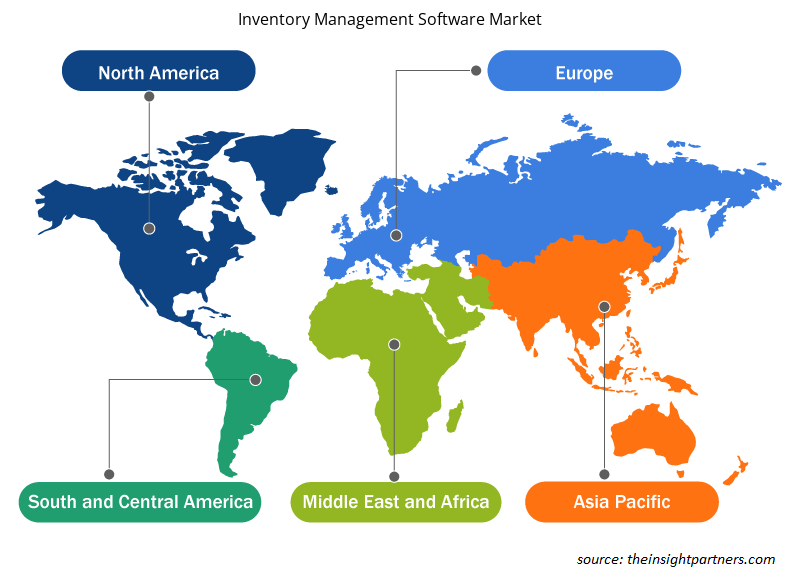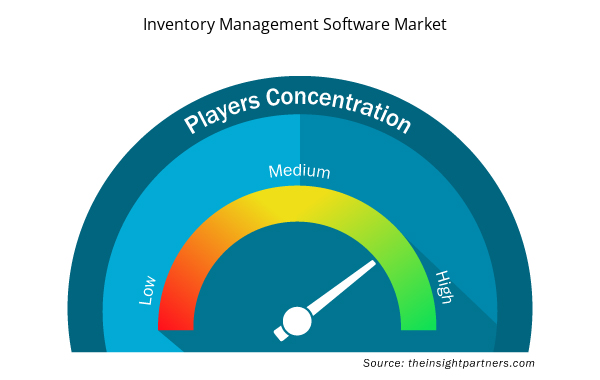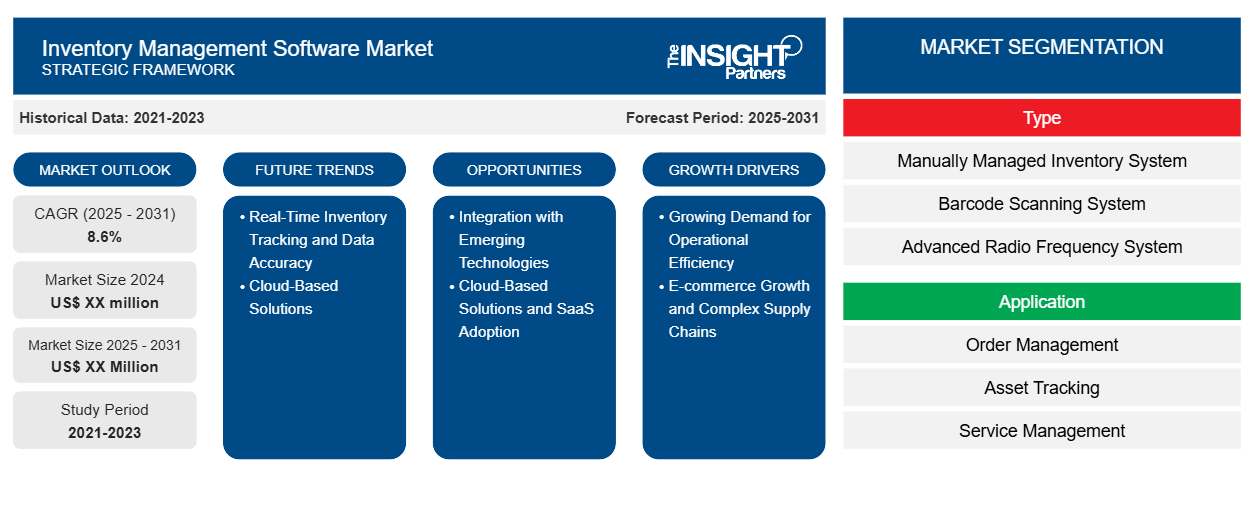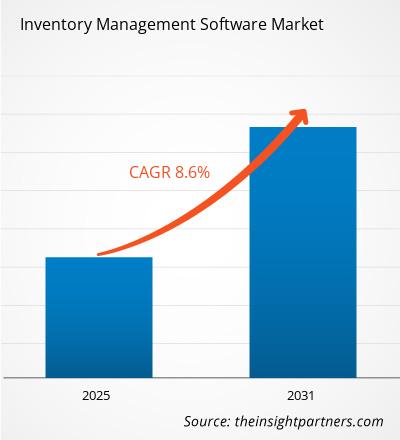在庫管理ソフトウェア市場は、2023年から2031年にかけて8.6%のCAGRを記録し、市場規模は2023年のXX百万米ドルから2031年にはXX百万米ドルに拡大すると予想されています。
レポートは、タイプ(手動管理在庫システム、バーコードスキャンシステム、高度な無線周波数システム(RFID))、アプリケーション(注文管理、資産追跡、サービス管理、製品の差別化、在庫最適化)、展開モデル(オンプレミス、クラウド)、組織規模(大規模、中小企業)、エンドユーザー(製造、ヘルスケア、消費財および小売、自動車、エネルギー)別にセグメント化されています。グローバル分析は、地域レベルと主要国でさらに細分化されています。レポートは、上記の分析とセグメントに対して米ドルでの値を提供します。
報告書の目的
The Insight Partners のレポート「在庫管理ソフトウェア市場」は、現在の状況と将来の成長、主な推進要因、課題、機会を説明することを目的としています。これにより、次のようなさまざまなビジネス関係者に洞察が提供されます。
- テクノロジープロバイダー/メーカー: 進化する市場の動向を理解し、潜在的な成長機会を把握することで、情報に基づいた戦略的意思決定が可能になります。
- 投資家: 市場の成長率、市場の財務予測、バリュー チェーン全体に存在する機会に関する包括的な傾向分析を実施します。
- 規制機関: 市場の濫用を最小限に抑え、投資家の信用と信頼を維持し、市場の完全性と安定性を維持することを目的として、市場における政策と警察活動を規制します。
在庫管理ソフトウェア市場のセグメンテーション
タイプ
- 手動で管理される在庫システム
- バーコードスキャンシステム
- 高度な無線周波数システム
応用
- 注文管理
- 資産追跡
- サービス管理
- 製品の差別化
- 在庫最適化
展開モデル
- オンプレミス
- 雲
組織規模
- 大きい
- 中小企業
組織規模
- 大きい
- 中小企業
要件に合わせてレポートをカスタマイズする
このレポートの一部、国レベルの分析、Excelデータパックなど、あらゆるレポートを無料でカスタマイズできます。また、スタートアップや大学向けのお得なオファーや割引もご利用いただけます。
- このレポートの主要な市場動向を入手してください。この無料サンプルには、市場動向から見積もりや予測に至るまでのデータ分析が含まれます。
在庫管理ソフトウェア市場の成長要因
- 業務効率に対する需要の高まり: さまざまな業界で業務効率に対する需要が高まっていることも、在庫管理ソフトウェアの成長を牽引するもう 1 つの大きな要因です。特に小売、製造、物流などの企業は、業務を最適化し、無駄を減らし、在庫切れや過剰在庫を回避する方法を常に模索してきました。在庫管理ソフトウェアを使用すると、在庫レベルをリアルタイムで追跡し、補充アラートを自動的に生成し、注文をより効率的に管理できるため、業務効率が向上し、コストが削減されます。最適化レベルを模索する中で、企業は、サプライ チェーンの可用性を向上させ、在庫製品を管理する自動化ソフトウェア ソリューションへと向かっています。
- 電子商取引の成長と複雑なサプライ チェーン: 電子商取引は、企業の在庫管理の実践に大きな影響を与えています。オムニチャネル ビジネスやオンライン小売業者は、さまざまな倉庫、場所、さらにはサードパーティのフルフィルメント センターにわたる在庫の管理に大きな課題に直面しています。在庫管理ソフトウェアは、さまざまなプラットフォームや場所にわたって在庫レベルをリアルタイムで同期することで、このような企業を支援します。これにより、正確な製品の在庫状況と迅速な配送時間が確保されます。この要因は、電子商取引の分野での在庫管理と注文対応の複雑さに関係しており、IMS ソリューションを利用するための重要な要素の 1 つとなっています。
在庫管理ソフトウェア市場の将来動向
- リアルタイム在庫追跡とデータ精度: 市場の成長を促す大きな要因の 1 つは、リアルタイム在庫監視の重要性が高まっていることです。在庫数量に関する正確な最新情報の必要性に応えるリアルタイム在庫追跡ソフトウェア ソリューション。これにより、企業はコストのかかる在庫切れを回避し、余剰在庫をなくし、注文処理プロセスを効率的に迅速化できます。2 つ目は、リアルタイム追跡により、企業はデータの整合性を向上させながら、質の高い調達の決定を下し、在庫と配送を適切に行うことができます。正確なリアルタイム データにアクセスすることで、サプライ チェーンの可視性を最大限に高め、サプライ チェーンのスムーズな運用を確保できるため、高度な在庫管理ソフトウェアの需要が常に高まっている必要があります。
- クラウドベースのソリューション: クラウドベースの在庫管理ソリューションへの移行は、その拡張性、柔軟性、コスト効率により勢いを増しています。組織は、在庫データへのリアルタイム アクセスを可能にし、チームや場所をまたいだコラボレーションを促進するクラウド プラットフォームを導入するケースが増えています。
在庫管理ソフトウェアの市場機会
- 新興技術との統合: IoT、AI、ML、ブロックチェーンなどの新興技術を在庫管理に統合すると、多くのイノベーションがもたらされます。IoT デバイスを通じて製品をリアルタイムで追跡できるため、在庫管理プロセスをより効率的に実行できます。AI と ML は在庫予測の最適化に役立ち、企業は購入、在庫、補充に関してより情報に基づいたデータ主導の意思決定を行うことができます。ブロックチェーン技術は、改ざん防止の在庫移動記録により、サプライ チェーンの透明性とセキュリティを促進できます。これらの技術を在庫管理ソリューションに統合できるため、サプライ チェーンの効率を高める、よりスマートで自動化されたシステムを構築できます。
- クラウドベースのソリューションと SaaS の採用: クラウドベースのソリューションは、在庫管理ソフトウェア市場で形成されつつある大きなトレンドの 1 つです。これらのクラウドベースの IMS システムは、企業がどこからでもリモートで在庫データを表示およびアクセスするのに非常に役立ち、特に複数のサイトや地理的に分散した場所を運営している企業にとって非常に便利です。SaaS モデルにより、企業はインフラストラクチャに最初に投資することなく、在庫管理システムを柔軟に拡張できます。クラウドベースのソリューションにより、自動更新が容易になり、他のソフトウェアとの統合が容易になり、セキュリティが強化されます。これにより、小規模企業から大企業まで、あらゆる規模の企業で IMS の使用が促進されます。
在庫管理ソフトウェア市場の地域別分析
予測期間を通じて在庫管理ソフトウェア市場に影響を与える地域的な傾向と要因は、Insight Partners のアナリストによって徹底的に説明されています。このセクションでは、北米、ヨーロッパ、アジア太平洋、中東およびアフリカ、南米および中米にわたる在庫管理ソフトウェア市場のセグメントと地理についても説明します。

- 在庫管理ソフトウェア市場の地域別データを入手
在庫管理ソフトウェア市場レポートの範囲
| レポート属性 | 詳細 |
|---|---|
| 2023年の市場規模 | XX百万米ドル |
| 2031年までの市場規模 | XX百万米ドル |
| 世界のCAGR(2023年~2031年) | 8.6% |
| 履歴データ | 2021-2022 |
| 予測期間 | 2024-2031 |
| 対象セグメント | タイプ別
|
| 対象地域と国 | 北米
|
| 市場リーダーと主要企業プロフィール |
|
在庫管理ソフトウェア市場のプレーヤー密度: ビジネスダイナミクスへの影響を理解する
在庫管理ソフトウェア市場は、消費者の嗜好の変化、技術の進歩、製品の利点に対する認識の高まりなどの要因により、エンドユーザーの需要が高まり、急速に成長しています。需要が高まるにつれて、企業は提供内容を拡大し、消費者のニーズを満たすために革新し、新たなトレンドを活用し、市場の成長をさらに促進しています。
市場プレーヤー密度とは、特定の市場または業界内で活動している企業または会社の分布を指します。これは、特定の市場スペースに、その市場規模または総市場価値に対してどれだけの競合相手 (市場プレーヤー) が存在するかを示します。
在庫管理ソフトウェア市場で事業を展開している主要企業は次のとおりです。
- オラクル
- SAP社
- マイクロソフト
- エピコール
- IBM
免責事項:上記の企業は、特定の順序でランク付けされていません。

- 在庫管理ソフトウェア市場のトップキープレーヤーの概要を入手
主なセールスポイント
- 包括的なカバレッジ: レポートでは、在庫管理ソフトウェア市場の製品、サービス、タイプ、エンドユーザーの分析を包括的にカバーし、全体的な展望を提供します。
- 専門家による分析: レポートは、業界の専門家とアナリストの深い理解に基づいてまとめられています。
- 最新情報: このレポートは、最新の情報とデータの傾向を網羅しているため、ビジネスの関連性を保証します。
- カスタマイズ オプション: このレポートは、特定のクライアント要件に対応し、ビジネス戦略に適切に適合するようにカスタマイズできます。
したがって、在庫管理ソフトウェア市場に関する調査レポートは、業界のシナリオと成長の見通しを解読し理解する道の先導役となることができます。いくつかの正当な懸念があるかもしれませんが、このレポートの全体的な利点は欠点を上回る傾向があります。
- 過去2年間の分析、基準年、CAGRによる予測(7年間)
- PEST分析とSWOT分析
- 市場規模価値/数量 - 世界、地域、国
- 業界と競争環境
- Excel データセット



Report Coverage
Revenue forecast, Company Analysis, Industry landscape, Growth factors, and Trends

Segment Covered
This text is related
to segments covered.

Regional Scope
North America, Europe, Asia Pacific, Middle East & Africa, South & Central America

Country Scope
This text is related
to country scope.
よくある質問
Some of the customization options available based on the request are an additional 3-5 company profiles and country-specific analysis of 3-5 countries of your choice. Customizations are to be requested/discussed before making final order confirmation as our team would review the same and check the feasibility
The report can be delivered in PDF/PPT format; we can also share excel dataset based on the request
Real-Time Inventory Tracking and Data Accuracy is anticipated to play a significant role in the global inventory management software market in the coming years
The major factors driving the inventory management software market are:
1. Growing Demand for Operational Efficiency
2. E-commerce Growth and Complex Supply Chains
The Inventory Management Software Market is estimated to witness a CAGR of 8.6% from 2023 to 2031
Trends and growth analysis reports related to Technology, Media and Telecommunications : READ MORE..
1. Oracle
2. SAP
3. Microsoft
4. Epicor
5. IBM
6. Logility
7. Inflow
8. JDA Software Group, Inc.
9. Sage Group plc
10. Fish Bowl
The Insight Partners performs research in 4 major stages: Data Collection & Secondary Research, Primary Research, Data Analysis and Data Triangulation & Final Review.
- Data Collection and Secondary Research:
As a market research and consulting firm operating from a decade, we have published and advised several client across the globe. First step for any study will start with an assessment of currently available data and insights from existing reports. Further, historical and current market information is collected from Investor Presentations, Annual Reports, SEC Filings, etc., and other information related to company’s performance and market positioning are gathered from Paid Databases (Factiva, Hoovers, and Reuters) and various other publications available in public domain.
Several associations trade associates, technical forums, institutes, societies and organization are accessed to gain technical as well as market related insights through their publications such as research papers, blogs and press releases related to the studies are referred to get cues about the market. Further, white papers, journals, magazines, and other news articles published in last 3 years are scrutinized and analyzed to understand the current market trends.
- Primary Research:
The primarily interview analysis comprise of data obtained from industry participants interview and answers to survey questions gathered by in-house primary team.
For primary research, interviews are conducted with industry experts/CEOs/Marketing Managers/VPs/Subject Matter Experts from both demand and supply side to get a 360-degree view of the market. The primary team conducts several interviews based on the complexity of the markets to understand the various market trends and dynamics which makes research more credible and precise.
A typical research interview fulfils the following functions:
- Provides first-hand information on the market size, market trends, growth trends, competitive landscape, and outlook
- Validates and strengthens in-house secondary research findings
- Develops the analysis team’s expertise and market understanding
Primary research involves email interactions and telephone interviews for each market, category, segment, and sub-segment across geographies. The participants who typically take part in such a process include, but are not limited to:
- Industry participants: VPs, business development managers, market intelligence managers and national sales managers
- Outside experts: Valuation experts, research analysts and key opinion leaders specializing in the electronics and semiconductor industry.
Below is the breakup of our primary respondents by company, designation, and region:

Once we receive the confirmation from primary research sources or primary respondents, we finalize the base year market estimation and forecast the data as per the macroeconomic and microeconomic factors assessed during data collection.
- Data Analysis:
Once data is validated through both secondary as well as primary respondents, we finalize the market estimations by hypothesis formulation and factor analysis at regional and country level.
- Macro-Economic Factor Analysis:
We analyse macroeconomic indicators such the gross domestic product (GDP), increase in the demand for goods and services across industries, technological advancement, regional economic growth, governmental policies, the influence of COVID-19, PEST analysis, and other aspects. This analysis aids in setting benchmarks for various nations/regions and approximating market splits. Additionally, the general trend of the aforementioned components aid in determining the market's development possibilities.
- Country Level Data:
Various factors that are especially aligned to the country are taken into account to determine the market size for a certain area and country, including the presence of vendors, such as headquarters and offices, the country's GDP, demand patterns, and industry growth. To comprehend the market dynamics for the nation, a number of growth variables, inhibitors, application areas, and current market trends are researched. The aforementioned elements aid in determining the country's overall market's growth potential.
- Company Profile:
The “Table of Contents” is formulated by listing and analyzing more than 25 - 30 companies operating in the market ecosystem across geographies. However, we profile only 10 companies as a standard practice in our syndicate reports. These 10 companies comprise leading, emerging, and regional players. Nonetheless, our analysis is not restricted to the 10 listed companies, we also analyze other companies present in the market to develop a holistic view and understand the prevailing trends. The “Company Profiles” section in the report covers key facts, business description, products & services, financial information, SWOT analysis, and key developments. The financial information presented is extracted from the annual reports and official documents of the publicly listed companies. Upon collecting the information for the sections of respective companies, we verify them via various primary sources and then compile the data in respective company profiles. The company level information helps us in deriving the base number as well as in forecasting the market size.
- Developing Base Number:
Aggregation of sales statistics (2020-2022) and macro-economic factor, and other secondary and primary research insights are utilized to arrive at base number and related market shares for 2022. The data gaps are identified in this step and relevant market data is analyzed, collected from paid primary interviews or databases. On finalizing the base year market size, forecasts are developed on the basis of macro-economic, industry and market growth factors and company level analysis.
- Data Triangulation and Final Review:
The market findings and base year market size calculations are validated from supply as well as demand side. Demand side validations are based on macro-economic factor analysis and benchmarks for respective regions and countries. In case of supply side validations, revenues of major companies are estimated (in case not available) based on industry benchmark, approximate number of employees, product portfolio, and primary interviews revenues are gathered. Further revenue from target product/service segment is assessed to avoid overshooting of market statistics. In case of heavy deviations between supply and demand side values, all thes steps are repeated to achieve synchronization.
We follow an iterative model, wherein we share our research findings with Subject Matter Experts (SME’s) and Key Opinion Leaders (KOLs) until consensus view of the market is not formulated – this model negates any drastic deviation in the opinions of experts. Only validated and universally acceptable research findings are quoted in our reports.
We have important check points that we use to validate our research findings – which we call – data triangulation, where we validate the information, we generate from secondary sources with primary interviews and then we re-validate with our internal data bases and Subject matter experts. This comprehensive model enables us to deliver high quality, reliable data in shortest possible time.


 このレポートの無料サンプルを入手する
このレポートの無料サンプルを入手する